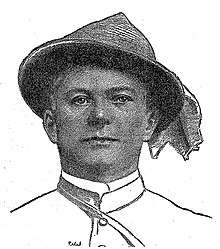Lee Christmas
Leon Winfield Christmas, usually called Lee Christmas, (February 2, 1863 – January 24, 1924) was an American mercenary in Central America.
Lee Christmas | |
|---|---|
 | |
| Born | February 2, 1863 |
| Died | January 24, 1924 (aged 60) New Orleans, Louisiana, United States |
Early life and career
Lee Christmas was born on February 2, 1863, on a plantation on the Amite River in Livingston Parish, Louisiana. As a young man, he worked as a pilot on tugboats on Lake Pontchartrain and later became a brakeman living in McComb, Mississippi, for the Illinois Central System in 1879. He helped to build the Louisville, New Orleans and Texas Railroad, and returned to passenger service as a baggage master before the line was completed. He then became a fireman and was later promoted to engineer.
Christmas ran locomotives between Memphis and New Orleans until 1891, when he fell asleep at the controls and ran by a flag, resulting in a collision with an oncoming train. Because he had been on duty for 54 hours when the accident occurred, he was not fired, but he was not allowed to return to his previous position because a company physical had discovered that he was color blind.[1][2]
Central America
In November 1894, he moved to Puerto Cortes, Honduras. Again employed as a railroad engineer, he was captured by rebels at Laguna Trestle on April 14, 1897, and joined their cause. He defected to the government forces in 1899 and was appointed a colonel and chief of police of Tegucigalpa by President Terencio Sierra, in May 1902. Defecting again in 1903, Christmas accepted a position as aide to rebel General Manuel Bonilla. When Bonilla became president of Honduras, he appointed Christmas a general. Perhaps to assert his toughness or to intimidate the natives, Christmas had been known to chew on glass.[3]
Bonilla's abortive invasion of Nicaragua in 1907 led to his overthrow by General Miguel Dávila. Christmas was wounded in the fighting and exiled to Guatemala, where he reconnected with Bonilla, with financing by "El Amigo" Samuel Zemurray who, by overthrowing President Davila in favor of Bonilla,[4] was trying to establish a business that would be competitive with United Fruit. Bonilla and Christmas led a failed revolution in 1910 against the artillery of the garrison at Tatumbla with two 42 mm field pieces previously supplied to the government forces by Zemurray.
Battle of La Ceiba
They had better luck the following year, with a reorganized force supplied with US Army surplus Colt Model 1895 machine guns. Bonilla's rebels captured Trujillo and Iriona, and cemented their victory at the Battle of La Ceiba on January 25, 1911. Christmas used his machine guns for fire support of the infantry with interlocking fields of fire, inflicting some six hundred casualties on the government forces.
This is believed to be the first time automatic weapons were so used, and La Ceiba was studied by military professionals in Europe and the Americas. This tactical use of machine guns would become standard practice in the First World War. Bonilla resumed the presidency of Honduras, with Christmas as his military commander, but Bonilla's sudden death in 1913 forced Christmas into exile once more.
For the next ten years, reports surfaced of Christmas being seen throughout Latin America. It may be that Zemurray invoked the threat of an appearance by Christmas to intimidate recalcitrant clients. His presence in the Mexican Revolution as an aide to Emiliano Zapata is impossible to confirm.
Suffering from tuberculosis, Christmas returned to Louisiana and died in New Orleans, one day before the thirteenth anniversary of his victory at La Ceiba. The New York Times article remembering him was titled "Gen. Lee Christmas, A Dumas Hero In Real Life".
He was widely written about in his lifetime, and is believed to be the inspiration for Richard Harding Davis' novels Captain Macklin and Soldiers of Fortune.[5]
The University of Tennessee has papers donated by Mrs. Marion Samson of Abilene, Texas in 1958.[6] They include correspondence to and from Christmas, and an invitation to his wedding to Ida Culotta at Puerto Cortés, Honduras, in 1914.
References
- Boston Globe, January 22, 1924, p. 9
- Marion Samson Collection of General Lee Christmas and President William Walker, MS-0014. University of Tennessee Libraries, Knoxville, Special Collections. Used with permission. Archived 2011-07-16 at the Wayback Machine
- Inevitable Revolutions: The United States in Central America. 2nd Edition, p. 45
- Rich Cohen, The Fish that Ate the Whale
- http://www.time.com/time/magazine/article/0,9171,717616,00.html
- Marion Samson Collection of General Lee Christmas and President William Walker, MS-0014. University of Tennessee Libraries, Knoxville, Special Collections. Archived 2011-07-16 at the Wayback Machine